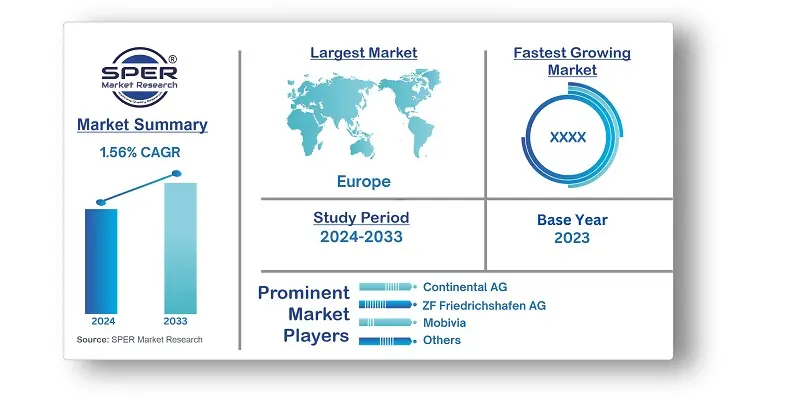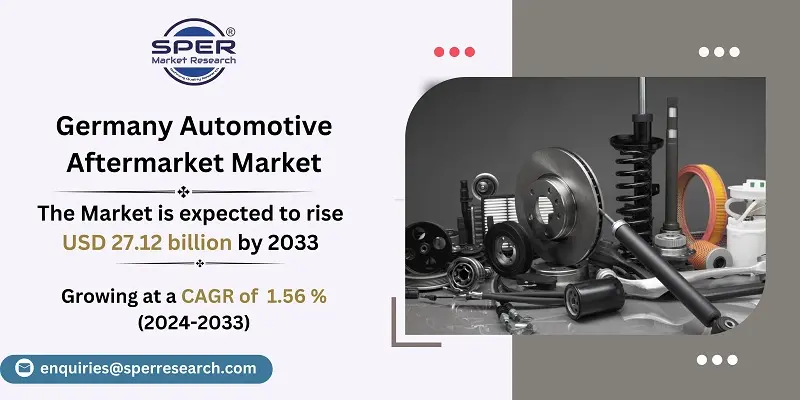
Germany Automotive Aftermarket Market Growth, Size, Trends, Share, Revenue and Future Outlook
Germany Automotive Aftermarket Market Size- By Replacement Part, By Distribution Channel, By Certification- Regional Outlook, Competitive Strategies and Segment Forecast to 2033
| Published: Mar-2024 | Report ID: AMIN2489 | Pages: 1 - 104 | Formats*: |
| Category : Automotive & Transportation | |||


| Report Metric | Details |
| Market size available for years | 2020-2033 |
| Base year considered | 2023 |
| Forecast period | 2024-2033 |
| Segments covered | By Replacement Part, By Distribution Channel, By Certification |
| Regions covered | Eastern Region, Western Region, Southern Region, Northern Region |
| Companies Covered | Continental AG, Compagnie Generale des Etablissements Michelin SCA, ZF Friedrichshafen AG, Mobivia, Others. |
- Automotive Dealerships
- Commercial Vehicle Operators
- Do it Yourself (DIY) Enthusiasts
- Fleet Management Companies
- Government Agencies and Regulatory Bodies
- Independent Repair Shops
- Insurance Companies
- Online Retail Customers
- Original Equipment Manufacturers (OEM’s)
- Vehicle Owners
| By Replacement Part: |
|
| By Distribution Channel: |
|
| By Certification: |
|
- Germany Automotive Aftermarket Market Size (FY’2024-FY’2033)
- Overview of Germany Automotive Aftermarket Market
- Segmentation of Germany Automotive Aftermarket Market By Replacement Part (Bed Tire, Battery, Brake parts, Filters, Body parts, Lighting & Electronic components
- Wheels, Exhaust components, Turbochargers, Others)
- Segmentation of Germany Automotive Aftermarket Market By Distribution Channel (Supermarkets and Hypermarkets, Specialty Stores, Online, Others)
- Segmentation of Germany Automotive Aftermarket Market By Certification (Genuine Parts, Certified Parts, Uncertified Parts)
- Expansion Analysis of Germany Automotive Aftermarket Market
- Problems and Obstacles in Germany Automotive Aftermarket Market
- Competitive Landscape in the Germany Automotive Aftermarket Market
- Impact of COVID-19 and Demonetization on Germany Automotive Aftermarket Market
- Details on Current Investment in Germany Automotive Aftermarket Market
- Competitive Analysis of Germany Automotive Aftermarket Market
- Prominent Players in the Germany Automotive Aftermarket Market
- SWOT Analysis of Germany Automotive Aftermarket Market
- Germany Automotive Aftermarket Market Future Outlook and Projections (FY’2024-FY’2033)
- Recommendations from Analyst
1.1. Scope of the report1.2. Market segment analysis
2.1. Research data source2.1.1. Secondary Data2.1.2. Primary Data2.1.3. SPER’s internal database2.1.4. Premium insight from KOL’s2.2. Market size estimation2.2.1. Top-down and Bottom-up approach
2.3. Data triangulation
4.1. Driver, Restraint, Opportunity and Challenges analysis4.1.1. Drivers4.1.2. Restraints4.1.3. Opportunities4.1.4. Challenges4.2. COVID-19 Impacts of the Germany Automotive Aftermarket Market
5.1. SWOT Analysis5.1.1. Strengths5.1.2. Weaknesses5.1.3. Opportunities5.1.4. Threats5.2. PESTEL Analysis5.2.1. Political Landscape5.2.2. Economic Landscape5.2.3. Social Landscape5.2.4. Technological Landscape5.2.5. Environmental Landscape5.2.6. Legal Landscape5.3. PORTER’s Five Forces5.3.1. Bargaining power of suppliers5.3.2. Bargaining power of buyers5.3.3. Threat of Substitute5.3.4. Threat of new entrant5.3.5. Competitive rivalry5.4. Heat Map Analysis
6.1. Germany Automotive Aftermarket Market Manufacturing Base Distribution, Sales Area, Product Type6.2. Mergers & Acquisitions, Partnerships, Product Launch, and Collaboration in Germany Automotive Aftermarket Market
7.1. Germany Automotive Aftermarket Market Value Share and Forecast, By Replacement, 2024-20337.2. Bed Tire7.3. Battery7.4. Brake parts7.5. Filters7.6. Body parts7.7. Lighting & Electronic components7.8. Wheels7.9. Exhaust components7.10. Turbochargers7.11. Others
8.1. Germany Automotive Aftermarket Market Value Share and Forecast, By Distribution Channel, 2024-20338.2. Retailers8.3. Wholesale & Distributors
9.1. Germany Automotive Aftermarket Market Value Share and Forecast, By Certification, 2024-20339.2. Genuine Parts9.3. Certified Parts9.4. Uncertified Parts
10.1. Germany Automotive Aftermarket Market Size and Market Share
11.1. Germany Automotive Aftermarket Market Size and Market Share By Replacement Part (2020-2026)11.2. Germany Automotive Aftermarket Market Size and Market Share By Replacement Part (2027-2033)
12.1. Germany Automotive Aftermarket Market Size and Market Share By Distribution Channel (2020-2026)12.2. Germany Automotive Aftermarket Market Size and Market Share By Distribution Channel (2027-2033)
13.1. Germany Automotive Aftermarket Market Size and Market Share By Certification (2020-2026)13.2. Germany Automotive Aftermarket Market Size and Market Share By Certification (2027-2033)
14.1. Germany Automotive Aftermarket Market Size and Market Share By Region (2020-2026)14.2. Germany Automotive Aftermarket Market Size and Market Share By Region (2027-2033)14.3. Eastern Region14.4. Northern Region14.5. Western Region
14.6. Southern Region
15.1. Continental AG15.1.1. Company details15.1.2. Financial outlook15.1.3. Product summary15.1.4. Recent developments15.2. Compagnie Generale des Etablissements Michelin SCA15.2.1. Company details15.2.2. Financial outlook15.2.3. Product summary15.2.4. Recent developments15.3. ZF Friedrichshafen AG15.3.1. Company details15.3.2. Financial outlook15.3.3. Product summary15.3.4. Recent developments15.4. Mobivia15.4.1. Company details15.4.2. Financial outlook15.4.3. Product summary15.4.4. Recent developments15.5. Others
SPER Market Research’s methodology uses great emphasis on primary research to ensure that the market intelligence insights are up to date, reliable and accurate. Primary interviews are done with players involved in each phase of a supply chain to analyze the market forecasting. The secondary research method is used to help you fully understand how the future markets and the spending patterns look likes.
The report is based on in-depth qualitative and quantitative analysis of the Product Market. The quantitative analysis involves the application of various projection and sampling techniques. The qualitative analysis involves primary interviews, surveys, and vendor briefings. The data gathered as a result of these processes are validated through experts opinion. Our research methodology entails an ideal mixture of primary and secondary initiatives.



Frequently Asked Questions About This Report
PLACE AN ORDER
Year End Discount
Sample Report
Pre-Purchase Inquiry
NEED CUSTOMIZATION?
Request CustomizationCALL OR EMAIL US
100% Secure Payment






Related Reports
Our Global Clients
Our data-driven insights have influenced the strategy of 200+ reputed companies across the globe.




















